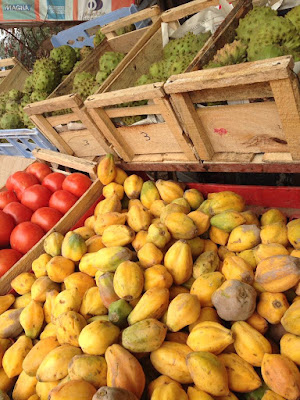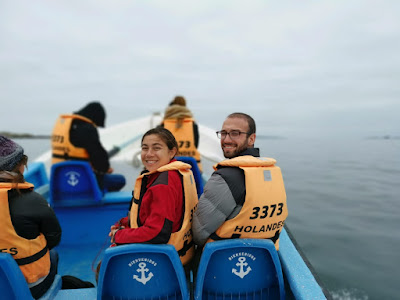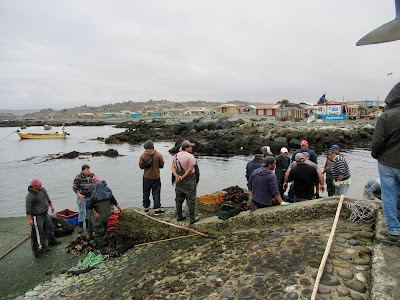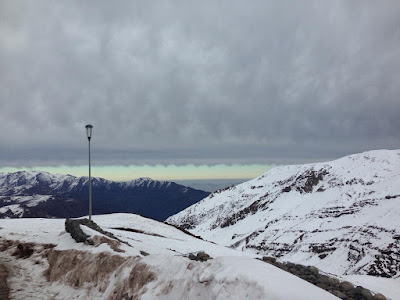This weekend we piled into a car with our two road trip guru guides, and set off to Fray Jorge National Park... or so we thought! The itinerary was in constant flux depending on how hungry we were, where we could find cheap accommodations for the night, and what we read online. Our actual first stop was Chinchilla National Park. Well, our ACTUAL actual first stop was breakfast. The small roadside restaurant we ate at, called "Hornitos", is notable for selling raw eggs and other "paila", or omelette, ingredients and letting customers cook their own meal on hot ashes. It's also notable for its lack of adequate tools for grasping and moving a hot pan filled with egg.
 |
| Cooking up some breakfast |
After breakfast, we had to make one more food stop. On our way past the town of La Ligua, famous for its merengue-and-dulce de leche pastries, vendors lined the highway waving white flags to attract motorists. We bought a bag of sweets to keep us energized on the long ride.
Chinchillas National Park is one of only two places where wild Chilean chinchillas are still found. Unfortunately, they are nocturnal so you can't actually see them in the wild there. It's still a nice place to go for a hike, and before we left, a park ranger took us through a small museum zoo-like area where we saw a chinchilla, and several other species of native rodent. The park is the site of a lot of research, so we also got to see exclusive footage of chinchillas roaming by night. You can see a video of the chinchillas here.
 |
| This is not a chinchilla- it's another cute rodent that was awake while we were at the National Park. |
 |
 |
| The photographers |
Day 2
We left La Serena and continued north, eventually reaching Punta de Choros. We have in fact been to this small seaside town before- to charter a boat tour of the Islas Damas. And that's exactly what we were there to do this time around as well. The first time we enjoyed beautiful weather, saw a pod of dolphins and a single lone penguin. This time the weather was grayer, we saw no dolphins, but we saw several more penguins. On both occasions sea lions and otters abounded. Our friends are avid photographers and were deeply disappointed by the cloudy weather, since it made for less striking contrasts in their photos. We'll let you judge.
| In Chile they call this a "chungungo" |
 |
| Penguins! |
 |
| Vultures eating a sea lion carcass. |
We continued north to just barely pass from the region of Coquimbo into the region of the Atacama, to visit another small port town where fisherman were hauling in a colossal amount of locos, a kind of Chilean abalone. From there we returned inland to the town of Vallenar, where we stayed the night in some cabañas of questionable quality.
 |
| The port of Caleta Chañaral de Aceituno |
| Locos, a Chilean delicacy, being harvested at port. We kept some shells for soap dishes. |
 |
We woke up having gone as far north as we were going to go- it was time to turn back and begin the long return towards Santiago. North-central Chile is punctuated by a series of latitudinal canyons where rivers flow from the Andes to the sea, and we found ourselves exploring a series of these canyons. The first stop was at a Dam that locks in runoff from the Andes and supplies water to the lower towns for the entire year.
 |
| The view from the dam on the way to Valle el Huasco |
Next, we went to two small towns in the mountains, both nearly deserted, both the home of well-known pisquerías (Alto de Carmen and el Horcon Quemado), but in both cases, the pisquerías were closed. However, while we admired a river in one of these towns, a local man struck up a conversation and showed us the orange grove he planted. He generously filled our backpacks with oranges, which we snacked on for the rest of the road trip.
 |
| Fruit stall along the road |
Eventually, lacking pisco but laden with oranges, we arrived in Pinte. Pinte is a very small town in the mountains. When we arrived, all 30 residents were deeply involved in a meeting/debate/election to decide what company to buy water from (all water is privatized in Chile). Due to the particular geological conditions in Pinte, there are thousands of fossils in its valley from when the region was under water millions of years ago. There is a museum with many particularly impressive specimens- mostly petrified shells and sharks teeth- which was closed. However, when we asked a local about the museum, they were able to find the museum manager at the town meeting, and he opened it up for us. Then we hiked out into the hills and, lo and behold, everywhere you looked was a fossilized shell!
 |
| Driving through Pinte |
 |
| The Church in Pinte |
 |
| An artistic map of the area |
 |
| Fossilized shells on display in the museum |
 |
| Many fossils were in large stones like this one, while others were single shells on the ground, mixed in with normal rocks |
 |
| It's hard to tell in this photo, but this hummingbird is HUGE- probably 6 inches long and maybe 9 inches from wingtip to wingtip. |
 |
| On our way out of the mountains we had an unexpected treat- artisanal homemade ice cream! We had cinnamon and manjar flavors. |
Day 4
Our last day, but not a lazy one! We went straight from Coquimbo to Fray Jorge National Park. A LONG time ago, this whole region of Chile was a rainforest. As the continent drifted, things changed, and now it's a desert, and the 'Valdivian' rainforests are in the south. But one part of the coast is hemmed in by mountains and is constantly shrouded in fog from the ocean, providing enough moisture for a little slice of forest to survive. The name "Fray Jorge" comes from the monk who discovered the forest. The story goes that he set out to find timber to build a church, and stumbled across a seemingly miraculous forest of trees in the middle of the desert.
 |
| The park is striking even from outside the forest- the fog pours over the mountains. |
 |
| The fog reminds us of the view from I-280 in California |
Getting to the park is a challenge. The path climbs almost straight up the mountains. It's rutted and sandy and we were not the only tourists there with a completely inadequate car. Even our intrepid driver struggled to get the car up the steeper parts (with pretty nerve-wracking drops to one side and very high winds). We eventually stopped to consider our next steps, and another car behind us soon also stalled out next to us. Luckily a tour van passed us on its way down and the driver jumped out and was able to drive both our car and the other struggling car up onto a less sandy, less steep section.
 |
| A foreboding sign |
As we crested the hill, the landscape changed dramatically. There was thick fog everywhere, and dense green vegetation. We walked along a path, which featured a lookout that apparently has an amazing view of the ocean- when there's no fog.
We'll end this blog post with a photo of our intrepid driver and navigator!































